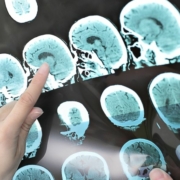Alzheimer’s Disease Early Diagnosis and Treatment
Alzheimer’s disease early diagnosis and treatment are two concerns that doctors, scientists, and researchers are heavily focusing on to better help patients in the future. Hope for future early Alzheimer’s treatment relies on new ways to diagnose the disease before mental decline has begun. New strategies are being tested and they include:
- Biomarkers for earlier detection
- Genetic risk profiling
- Searching for proteins in cerebrospinal fluid
- Imaging and neuroimaging of the brain
- New blood tests
BIOMARKERS FOR EARLIER DETECTION
Biomarkers are one of the newest potential tell-tale signs of early Alzheimer’s disease. Research is ongoing on this technology and method of detection. Some biomarkers being studied include beta-amyloid and tau levels. Beta-amyloid deposits of protein fragments are known to build up in between nerve cells. Tau, another protein, resembles twisted fibers that build up inside cells. It is the damage and subsequent death of nerve cells that cause memory failure and other aspects of the disease.
GENETIC RISK PROFILING
To help with Alzheimer’s disease early diagnosis and treatment, another tool to be used could be genetic risk profiling. Three genes have been noted by scientists to be present when Alzheimer’s disease is inherited. These genes increase the risk of getting the disease, but don’t fully guarantee that the person will get it; it just assesses that their risks are higher. Clinical trials are being undertaken to test for APOE-e4, which has shown to be a high-risk gene within some groups.
PROTEINS IN CEREBROSPINAL FLUID
Cerebrospinal fluid acts to cushion areas around the spinal cord and the brain. It is believed that Alzheimer’s disease causes changes in the levels of this fluid. The two biomarkers discussed above are two found in this fluid, along with neurofilament light, which can also possibly attest to early-onset Alzheimer’s disease. Standardizing the measurement of these markers is ongoing, and the validity of test results must be assessed.
BRAIN IMAGING AND NEUROIMAGING
Looking at images of the brain is a current detection method for Alzheimer’s disease. Some tools include MRIs (magnetic resonance imaging), CT scans (computed tomography), PET scans (positron emission tomography), fMRI (functional magnetic resonance imaging), and SPECT (single-photon emission computed tomography). Research is continuing to look into these tools to see how they can play a bigger role in Alzheimer’s disease early diagnosis and treatment.
NEW BLOOD TESTS
Blood tests can also tell the presence of biomarkers. New testing methods that are inexpensive, simple, and non-invasive need to be developed to be of better assistance in detecting Alzheimer’s disease early diagnosis and treatment. Blood tests are not currently routinely used, and researchers are continuing efforts of standardizing blood tests and certifying their validity. Blood tests could be a tremendous help in understanding the progression of the disease, as well as supporting drug development for early Alzheimer’s treatment options.
CURRENT ALZHEIMER’S DISEASE DIAGNOSIS METHODS
The diagnosis of Alzheimer’s disease during the early stages can be difficult. Currently, there is no one-size-fits-all test for the disease. The early symptoms of the disorder are not specific and can be confused with many other disorders. For people who may have early-onset Alzheimer’s disease, the diagnosis is based on several tests that assess thinking and memory skills. These tests are in the form of questionnaires and pictorials that can provide a clue for healthcare workers as to what disorder the patient may be experiencing. In general, laboratory tests are usually done to rule out other potential causes of memory loss and behavioral disorders.
In the past, the diagnosis of Alzheimer’s disease was only made after death, following an autopsy on sections of the brain that were examined under a microscope to look for the typical tangles and plaques. However, today, healthcare workers are able to make a diagnosis of Alzheimer’s disease during life with more certainty. In fact, advances in brain imaging, such as PET scans and those imaging techniques mentioned above, can help assess the presence of amyloid (also known as beta-amyloid) proteins.
TREATMENT OPTIONS
It is important to understand that Alzheimer’s disease is managed with both medical and non-medical therapies. There is no treatment available today that can slow down the progression or prevent Alzheimer’s disease. The use of medical therapies is to manage behavioral disorders and thinking, whereas non-medical therapies are supportive and help improve the quality of life.
DRUG THERAPY
At present, there are two classes of drugs that can help manage cognitive and memory loss symptoms. These agents work best when used early in the course of the disease. Unfortunately, these drugs do not work in all patients and there is no way of knowing ahead of time who will respond and who won’t. Finding answers for early Alzheimer’s treatment options is of high importance to scientists and researchers.
Cholinesterase Inhibitors
These agents work by increasing the level of the neurotransmitter acetylcholine in the brain, which facilitates neural communication. These medications are usually the first drugs to be tried and a fair number of Alzheimer’s patients see improvement in thinking and memory. In some people, these agents may also improve neuropsychiatric features like depression, anxiety, or agitation. The currently available cholinesterase inhibitors include:
- donepezil (Aricept)
- galantamine (Razadyne ER)
- rivastigmine (Exelon)
Unfortunately, these drugs can also have adverse side effects that include:
- Nausea
- Diarrhea
- Difficulty sleeping
- Loss of appetite
- In people with heart disease, the drugs may also lead to abnormal heartbeats
Memantine
Memantine (Namenda) acts on a different neurotransmitter to enhance the communication between the brain cells. It is usually used to manage moderate or severe symptoms of Alzheimer’s disease and can even be combined with a cholinesterase inhibitor. Side effects of the drug can include confusion and dizziness.
Newer Biological Drugs
Just recently, the U.S. FDA approved the use of aducanumab for the treatment of select cases of Alzheimer’s disease. This is the first drug approved to remove the amyloid plaque in the brain. However, more studies are needed to determine which patients will benefit from this agent.
Miscellaneous Medications
Because Alzheimer’s patients often develop extreme anxiety, depression, anger, and paranoia, sometimes there is a need to use an antidepressant, antipsychotic, and/or antianxiety agents. These agents are used for a short-term period and can help control the behavioral symptoms associated with Alzheimer’s disease.
CAREGIVERS
Caring for an individual with Alzheimer’s disease is physically and mentally exhausting. As a caregiver, you may develop guilt, anger, discouragement, grief, and enormous stress. In addition, social isolation is very common. Hence, pay attention to your needs and join a support group. Seek help from friends and family members and take frequent breaks from caregiving. Remember to take care of your own health by eating healthy, exercising, and socializing. Today, there are many resources for caregivers available from the Alzheimer’s Association. These resources can help you get connected to healthcare providers, home care agencies, support groups, and therapists.
CANO HEALTH
Cano Health is an organization that is committed to changing patient care for the better. There are several locations to serve you. The goal of Cano Health is to treat patients like family, providing seniors with superior primary care. To that end, many programs have been put into place to help seniors receive better clinical outcomes, while also lowering the cost of healthcare. To learn more about the services of Cano Health, call 1-855-975-5119 today.










